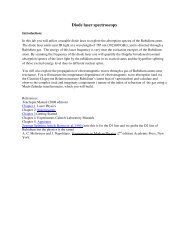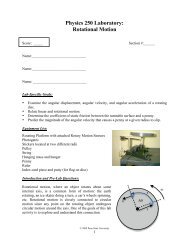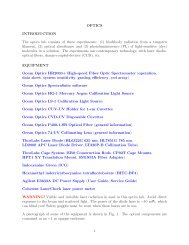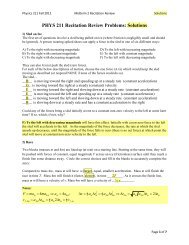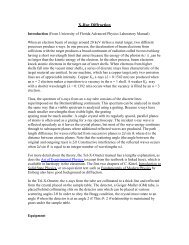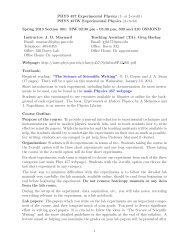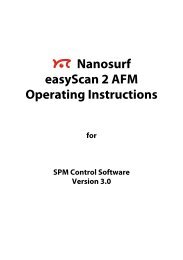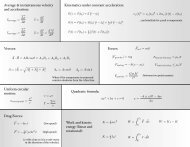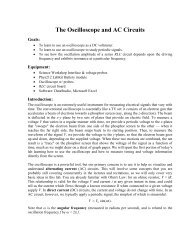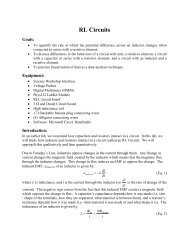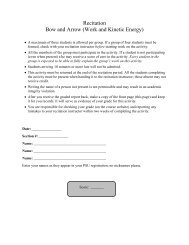Playing Physics Jeopardy
Playing Physics Jeopardy
Playing Physics Jeopardy
Create successful ePaper yourself
Turn your PDF publications into a flip-book with our unique Google optimized e-Paper software.
A third strength of these problems is that they help the<br />
students learn to translate between representations in a more<br />
robust manner. By robust we mean that they develop a stronger<br />
understanding of each representation—the verbal problem<br />
statement, the everyday picture-like representation, the<br />
physics representation, and the mathematical equation. They<br />
also learn to convert one representation into another and in<br />
any direction. To do this, each representation must have<br />
meaning for the student.<br />
A fourth strength of these problems is that they are easy to<br />
create. All you need is an existing problem from the back of<br />
the chapter of a physics book. Simply apply in equation form<br />
the fundamental principle needed to solve the problem. You<br />
have a <strong>Jeopardy</strong> Equation Problem. Or construct a diagram<br />
or graph that describes the problem. You have a <strong>Jeopardy</strong><br />
Diagram or Graph Problem.<br />
A fifth strength of <strong>Jeopardy</strong> Problems depends on their use<br />
in homework assignments and on tests. If students realize<br />
that <strong>Jeopardy</strong> Problems will appear on tests, the students are<br />
encouraged to think more deeply about standard end-ofchapter<br />
problems and to use multiple representations of<br />
physics processes to describe these problems.<br />
A weakness of <strong>Jeopardy</strong> Problems stems from the fact that<br />
they are novel for students. Any new problem format has<br />
some learning associated with it that is independent of the<br />
particular problem content. Students develop mechanisms for<br />
coping with free response, multiple choice, and essay questions<br />
on tests. They need practice with <strong>Jeopardy</strong> Problems<br />
before they are used on tests. It is important to start with<br />
relatively easy one-equation examples so students develop<br />
skill at solving such problems.<br />
There might also be concern about grading these problems.<br />
The authors find them easier to grade than standard<br />
problems presented in a free-response format. For <strong>Jeopardy</strong><br />
Problems, students present diagrams, graphs, bar charts, and<br />
sketches as part of the solution—seldom seen with traditional<br />
problems. The problems can even be presented in a<br />
multiple choice format by asking students to choose the one<br />
of five versions of one representation for example, five<br />
graphs that best matches the description of a situation in the<br />
form of another representation for example, an equation.<br />
VI. IMPACT ON STUDENT LEARNING<br />
The authors use one or more pedagogical innovations in<br />
their courses Active Learning Problem Sheets, Context-Rich<br />
Problems, Activ<strong>Physics</strong> interactive simulations, Ranking<br />
Tasks, and <strong>Jeopardy</strong> Problems. It is difficult to say what<br />
impact any one of these innovations has on student learning<br />
as measured by various types of tests. The widely used Mechanics<br />
Baseline Test MBT, a problem-solving test with a<br />
strong conceptual base, might be one of the better measures<br />
of students’ ability to use the math language of physics with<br />
understanding—a main goal for using <strong>Jeopardy</strong> Problems.<br />
During the last two years, one author AVH has taught<br />
calculus-ready freshmen engineers—honors students in their<br />
engineering course. <strong>Jeopardy</strong> Problems were used routinely<br />
on their tests. They scored 78 on the MBT during the winter<br />
of 1997 and 77 during the fall 1997. These scores are equal<br />
to and perhaps slightly higher than the best scores reported<br />
by Hake for 3259 students from different colleges, including<br />
a prestigious Ivy League university. 15 The fall 1997 class<br />
scored 86 on the Force Concept Inventory Test, a qualitative<br />
reasoning test concerning mechanics. Representing physical<br />
processes in multiple ways, including the use of <strong>Jeopardy</strong><br />
Problems, we believe has a very positive effect on students’<br />
ability to use the math language of physics with understanding.<br />
What do students say about <strong>Jeopardy</strong> Problems? One of us<br />
DVM has used <strong>Jeopardy</strong> Problems as homework assignments<br />
in a calculus-based introductory physics course. At the<br />
end of each semester, he asks students to identify the five<br />
homework assignments from which they learned the most<br />
and the five assignments from which they learned the least,<br />
and to explain why. One class was also asked to identify the<br />
advantages and disadvantages of each problem type. <strong>Jeopardy</strong><br />
Problems were identified as difficult. Several student<br />
comments follow:<br />
‘‘The advantage of this type of homework was the use<br />
of looking at equations and seeing how they apply in<br />
the real world.’’<br />
‘‘I spent a very long time on this one, repeated it over<br />
and over. I think because it gave the force equations and<br />
ask to draw free body diagrams and a physical situation<br />
it forced me to analyze the equations until I knew exactly<br />
what everything meant.’’<br />
‘‘Even though I hated this one, it made me think ... a<br />
lot. Instead of just giving me the situation and asking<br />
me to find the answer, you turned the tables and had me<br />
work through the situation the opposite way I normally<br />
would have. I had to use the equations and come up<br />
with a reasonable physical situation and this was you<br />
could say rather ‘stimulating.’ ’’<br />
Learning to read with understanding the equations of physics<br />
is a challenging task for our students and a task that is not<br />
addressed by typical end-of-chapter problems.<br />
VII. SUMMARY AND CONCLUSION<br />
This article has presented a new format for physics problems.<br />
The format essentially reverses the usual solution sequence<br />
by providing the mathematical equation as the starting<br />
point, normally the next to last point of the solution<br />
process. Solvers then construct from the equation one, or<br />
more, of the following: a physics representation, an everyday<br />
picture-like representation, or a verbal description of the<br />
physical situation. Other versions of <strong>Jeopardy</strong> Problems start<br />
with diagrams, graphs, or bar charts. A wide variety of problems<br />
can be developed using this format. These problems<br />
range in difficulty from reasonably straightforward to very<br />
complex. The format is useful in all topic domains of physics<br />
and at all levels of physics—remember Feynman’s S-matrix<br />
problem.<br />
The value of this problem format is that it helps students<br />
develop a new perspective for both the problem-solving process<br />
and for the use of different representations to model<br />
physical processes. The equation description of a process is<br />
now regarded more as a short story about some aspect of<br />
life—about a physical process—and less as a set of symbols<br />
that must be solved numerically to answer a question. The<br />
problem solution becomes an effort to represent a physical<br />
process in a variety of ways—sketches, diagrams, graphs,<br />
and equations—more like the method used by experienced<br />
physicists when analyzing problems. <strong>Jeopardy</strong> Problems help<br />
students develop a better understanding and appreciation for<br />
the representations needed to solve problems with understanding.<br />
255 Am. J. Phys., Vol. 67, No. 3, March 1999<br />
A. Van Heuvelen and D. P. Maloney 255



